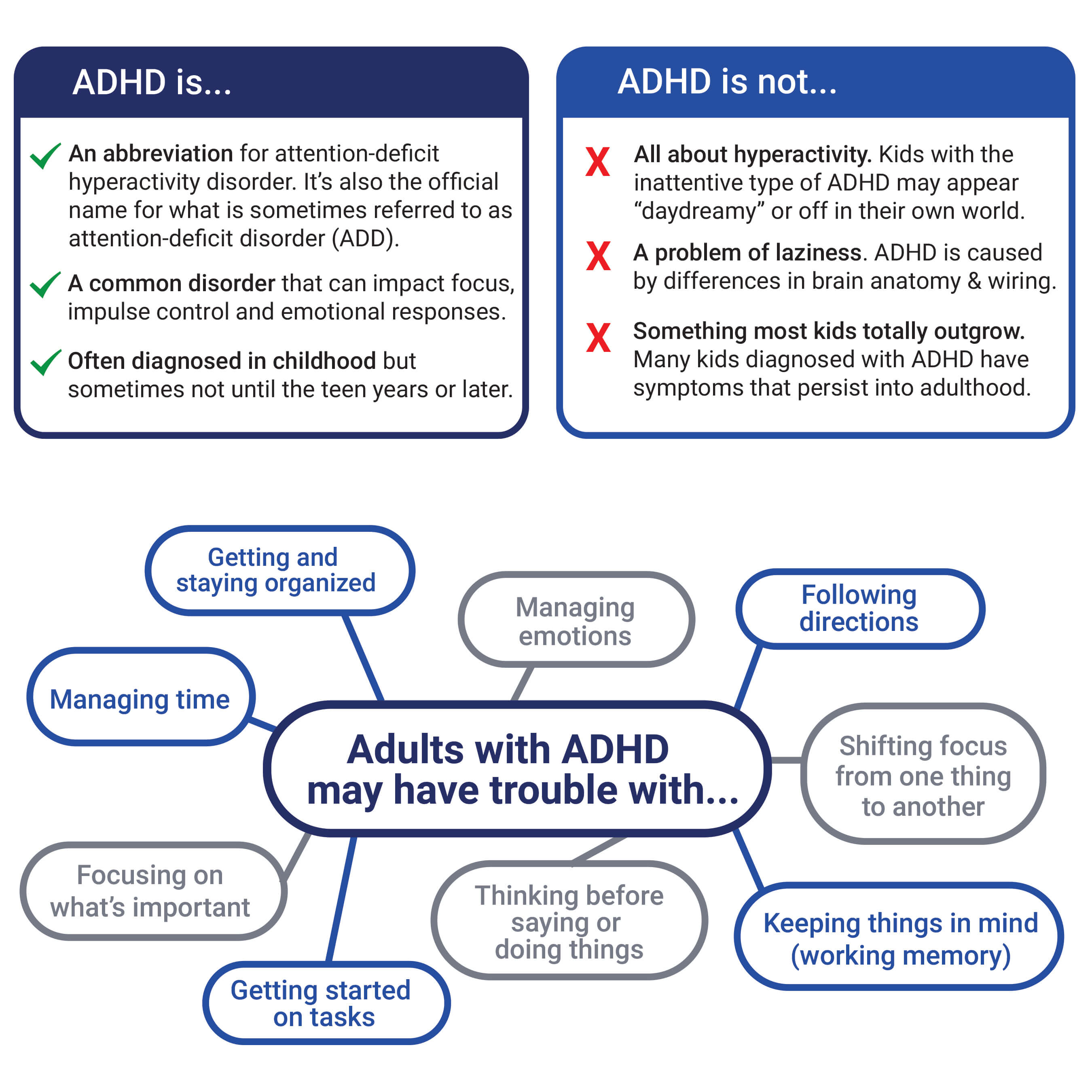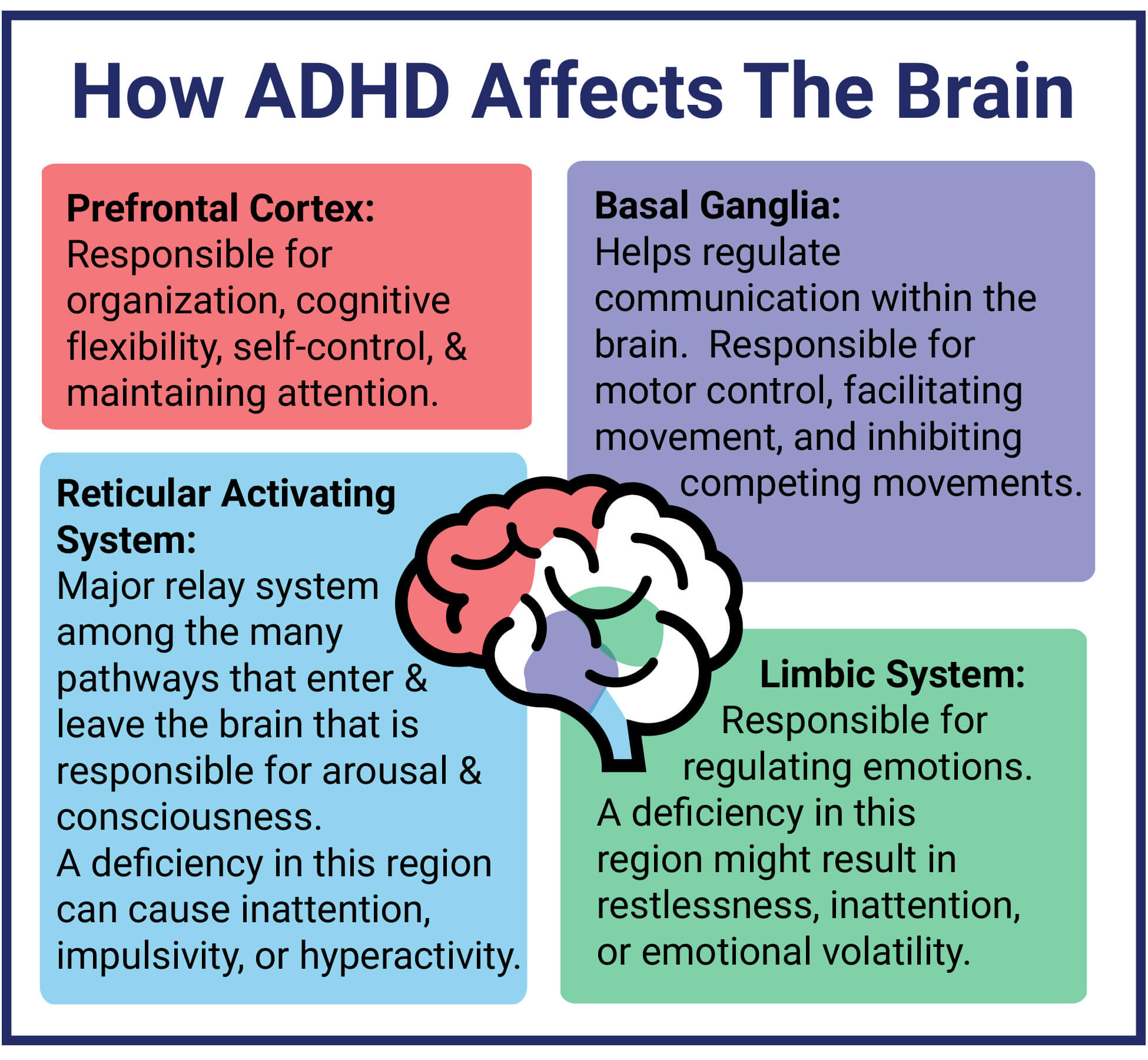Attention-Deficit/ Hyperactivity Disorder (ADHD) is one of the most common conditions that is diagnosed among children.
A common misconception is that ADHD only impacts children. Children with ADHD can continue to have signs of ADHD as an adult.
An estimated 8.4 percent of children are diagnosed with ADHD. Two-thirds of children diagnosed with ADHD continue to have signs of ADHD as adults. An estimated 2.5 percent of adults are diagnosed with ADHD.
ADHD is one of the most common conditions that we evaluate for in teenagers and adults. If left untreated, ADHD can cause significant impairment in school, at work, and in an individual’s social life.
ADHD might seem like a fairly straightforward condition to diagnose but based on our experience that’s not always the case.
ADHD is often incorrectly diagnosed and most people don’t understand what ADHD is.
The goal of this blog post is to explain the signs and symptoms of ADHD, the causes of ADHD, answer the most common questions people have about ADHD and discuss how we evaluate and treat ADHD.
What is ADHD?
ADHD is a neurodevelopmental disorder which means that individuals are born with it. ADHD is almost twice as common among males compared to females.
Males (especially children) have more hyperactive symptoms whereas females tend to have more inattentive symptoms. Since females tend to have more inattentive symptoms, their ADHD can go undiagnosed for many years.
Teachers and parents will notice a boy that is hyperactive but won’t notice a girl that keeps to herself but has difficulty with focus and attention.
Parents first start to notice symptoms when their children are very young but they tend to miss the signs because hyperactivity to a certain extent is normal in children.
As children get older, the symptoms of hyperactivity become less obvious BUT they continue to have problems with restlessness, inattention, poor planning, and impulsivity.
ADHD doesn’t go away just because someone gets older! The symptoms just look different and can vary depending on the age of the individual.
For example, an adult with ADHD will not get up and run around a classroom in college or at their job because they understand that it’s not appropriate behavior. They might fidget in their seat, tap their feet constantly, or not be able to focus on a task they have to complete at work or school.
People incorrectly assume that individuals with ADHD are lazy or don’t want to control their behavior.
The truth is that they can’t help themselves. They can’t sit still, pay attention, or focus no matter how hard they try.

We’ll talk about some of the neurological causes of ADHD in the next section but for now, let’s focus on the areas that individuals with ADHD struggle with.
Individuals with ADHD have difficulty with skills that involve executive function. Executive functions include the following:
- Working Memory: The ability to keep information in your mind to use it later. For example, to read a paragraph and answer questions or to read a math problem and solve it in your head.
- Cognitive Flexibility (Flexible thinking): The ability to think about something in more than one way. For example, figuring out an alternate way to achieve a goal or the desired result.
- Inhibitory Control (Self-Control): The ability to ignore distractions, resist impulses and control your emotions and behaviors. For example, waiting for your turn to speak in class rather than blurting out a question or answer.
What Are the Signs and Symptoms of ADHD?
ADHD can look different depending on the type of ADHD that the person has. We’ve included an overview of the signs and symptoms of ADHD. These are the criteria that we use to give an ADHD diagnosis.
There are three subtypes of ADHD:
- ADHD Inattentive Type
- ADHD Hyperactive Type
- ADHD Combined Type (symptoms for both inattentive and hyperactive type are present)
Diagnosis is based on the symptoms that have occurred over the past six months. Each type requires at least 6 symptoms (5 symptoms for adults or older teenagers). Several of the symptoms had to have been present prior to age 12.
Inattentive Type Symptoms:
- Often fails to give close attention to details or makes careless mistakes in schoolwork, at work, or during other activities (e.g., overlooks or misses details, work is inaccurate).
- Often has difficulty sustaining attention in tasks or play activities (e.g., has difficulty remaining focused during lectures, conversations, or lengthy reading).
- Often does not seem to listen when spoken to directly (e.g., mind seems elsewhere, even in the absence of any obvious distraction).
- Often does not follow through on instructions and fails to finish schoolwork, chores, or duties in the workplace (e.g., starts tasks but quickly loses focus and is easily sidetracked).
- Often has difficulty organizing tasks and activities (e.g., difficulty managing sequential tasks; difficulty keeping materials and belongings in order; messy, disorganized work; has poor time management; fails to meet deadlines).
- Often avoids, dislikes, or is reluctant to engage in tasks that require sustained mental effort (e.g., schoolwork or homework; for older adolescents and adults, preparing reports, completing forms, reviewing lengthy papers).
- Often loses things necessary for tasks or activities (e.g., school materials, pencils, books, tools, wallets, keys, paperwork, eyeglasses, mobile telephones).
- Is often easily distracted by extraneous stimuli (for older adolescents and adults, may include unrelated thoughts).
- Is often forgetful in daily activities (e.g., doing chores, running errands; for older adolescents and adults, returning calls, paying bills, keeping appointments).
Hyperactive Type Symptoms:
- Often fidgets with or taps hands or feet or squirms in seat.
- Often leaves the seat in situations when remaining seated is expected (e.g., leaves his or her place in the classroom, in the office or another workplace, or in other situations that require remaining in place).
- Often runs about or climbs in situations where it is inappropriate. (Note: In adolescents or adults, may be limited to feeling restless.)
- Often unable to play or engage in leisure activities quietly.
- Is often “on the go,” acting as if “driven by a motor” (e.g., is unable to be or uncomfortable being still for an extended time, as in restaurants, meetings; may be experienced by others as being restless or difficult to keep up with).
- Often talks excessively.
- Often blurts out an answer before a question has been completed (e.g., completes people’s sentences; cannot wait for turn in conversation).
- Often has difficulty waiting for his or her turn (e.g., while waiting in line).
- Often interrupts or intrudes on others (e.g., butts into conversations, games, or activities; may start using other people’s things without asking or receiving permission; for adolescents and adults, may intrude into or take over what others are doing).
The most important thing to remember is that these symptoms can’t be due to another mental health disorder.
For example, if an individual has really bad anxiety or is depressed and it’s causing them to have difficulty with focus and attention, they won’t qualify for the ADHD – Inattentive Type diagnosis.
Lastly, the symptoms have to interfere with the individual’s quality of life in either social, academic, or occupational contexts. If you’re experiencing some of these symptoms but they are not interfering with your quality of life then you don’t meet the diagnostic criteria for ADHD.
What are the Causes of ADHD?
Researchers aren’t certain what causes ADHD. There is evidence to suggest that ADHD has a genetic component to it. For example, 3 out of 4 children with ADHD have a relative with the disorder.
Other factors that can contribute to the development of ADHD include the following:
- Pre-mature birth
- Low birth weight
- Pediatric brain injury
- Exposure to lead during pregnancy
- Maternal drug or alcohol use during pregnancy
We’re not going to get into the complete neurobiology of ADHD. There are whole books dedicated to that topic and it’s beyond the scope of this blog post.
We did want to provide a very simplified breakdown of the areas of the brain that are impacted in individuals with ADHD.
The main regions of the brain that are impacted by ADHD include the following:
These regions of the brain are responsible for a variety of executive functions ranging from those that require inhibition of motor responses to those that require task switching and cognitive flexibility.
Additional regions that are impacted by ADHD include the following:
- Limbic System (regulates emotion and attention)
- Reticular Activating System (regulates wakefulness, attention, and sleep-wake transitions)

Within these regions of the brain, there are chemical messengers called neurotransmitters that help send signals to the various regions of the brain.
Individuals with ADHD tend to have low levels of a specific group of neurotransmitters called catecholamines, specifically dopamine and norepinephrine.
Decreased levels of dopamine and norepinephrine cause these regions of the brain to be underactive. If those regions are underactive then they can’t do their jobs as quickly or efficiently.
That’s why individuals will have difficulty with executive functions such as inhibitory control, working memory, and cognitive flexibility
The active ingredients in medications like Ritalin, Adderall, Concerta, or Strattera help increase the amount of dopamine and/or norepinephrine in the brain.
Increased levels of dopamine and/or norepinephrine can help activate the Dorsolateral Prefrontal Cortex and Ventrolateral Prefrontal Cortex and improve with executive functions such as inhibitory control, working memory, and cognitive flexibility.
That’s why individuals with ADHD take stimulant medications even though they have signs of hyperactivity. The stimulant medications don’t increase hyperactivity but rather they increase the activity in the regions of the brain that control inhibition, working memory, and cognitive flexibility.
How Do You Diagnose ADHD?
ADHD is typically diagnosed by a neuropsychologist or psychiatrist. Based on our experience, most psychiatrists like to refer clients to a neuropsychologist for neuropsychological testing prior to diagnosing and treating ADHD.
The reason for this is because there are other psychiatric and neurological conditions that can cause poor attention, concentration, or impulsivity.
A comprehensive neuropsychological evaluation for ADHD can help identify the underlying neurological signs of the condition and provide a much more accurate diagnosis.
An evaluation for ADHD typically consists of the following:
- A comprehensive clinical interview to help us understand important psychological, medical, educational, and social background information as well as current cognitive and psychological functioning.
- Review of medical, psychological, and school records that help us have a better understanding of psychological functioning and academic performance.
- Administration of neuropsychological and psychological tests to evaluate attention, concentration, and focus. The tests usually consist of the following:
- A symptom report questionnaire where either the client or their parent reports the problems with attention, concentration, or focus they currently have or had in the past.
- A general personality questionnaire to help screen for other problems that could be impacting attention and concentration such as life stress, depression, or anxiety.
- Neuropsychological tests that assess for general intellectual abilities, sustained attention, concentration, and focus, and executive functions.
- A comprehensive report that will summarize all of the information from the testing session and provide treatment recommendations.
- A feedback session to go over the results of the testing and discuss recommendations for treatment.
How Do You Treat ADHD?
So how do you treat ADHD once a diagnosis is established?
ADHD is a neurological condition and there is no cure but it can be treated through a combination of medication and therapy.
ADHD is treated with medications that target dopamine and/or norepinephrine.
Stimulant based medications help increase the amount of dopamine in the brain. Examples of stimulant medications include Ritalin, Adderall, and Concerta.
Non-stimulant based medications help increase the amount of norepinephrine in the brain. Strattera is a non-stimulant based medication that is typically prescribed when stimulant medications are not well-tolerated or preferred.
You should refer any medication-related questions to your treating psychiatrist.
In some situations, cognitive behavioral therapy (CBT) is recommended for people with ADHD. CBT can help provide a framework on how to manage emotions and behavior. It can help you learn how to monitor and regulate your behaviors and thoughts.
CBT can also help educate a child or adults regarding their symptoms and how to deal with the challenges they might encounter on a day-to-day basis. Social skills groups can be helpful for children or teenagers who have difficulty making and keeping friends due to their impulsivity or behavioral problems.
In a classroom setting, a student might benefit from academic accommodations in the form of an Individualized Education Plan (IEP) or 504 Plan.
If you’re a student that’s about to standardized test, you can also be eligible for testing accommodations.
Conclusion
Attention-Deficit/ Hyperactivity Disorder (ADHD) is one of the most common conditions that is diagnosed among children. It’s a neurodevelopmental disorder which means that children are born with it.
ADHD doesn’t go away just because someone gets older. The symptoms look different and can vary depending on the age of the individual.
Individuals with ADHD have difficulty with skills that involve executive functions such as working memory, cognitive flexibility (flexible thinking), and inhibitory control (self-control)
Researchers are not sure what causes ADHD but they know that individuals with ADHD tend to have low levels of a specific group of neurotransmitters called catecholamines, specifically dopamine and norepinephrine.
Although there is no cure with ADHD, it is treatable through a combination of medication management and cognitive behavioral therapy (CBT).
In some cases, students can qualify for accommodations through an Individualized Education Plan (IEP) or 504 Plan or qualify for accommodations on standardized tests.
We’re hoping this blog post answered your questions and provided helpful information about the signs ADHD and how it’s diagnosed and treated.
You can learn more about how we conduct ADHD evaluations here.


